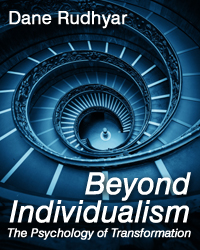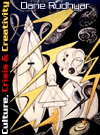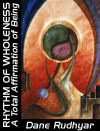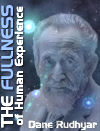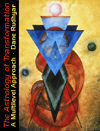Beyond Individualism
The Psychology of Transformation
by Dane Rudhyar
PART ONE:
THE PERSONAL-INDIVIDUAL MODE
3. Seed Functions and Rites of Passage
Functions of Transition and Rites of Passages
In attempting to outline the character of functions of the four orders or levels of human activity, I purposely made only passing reference to the kind of functions which, though still belonging to a lower order of which they are the culmination, serve as a matrix or seed out of which the 'higher' functions emerge, gradually unfolding their until-then latent potentialities. In the past, Western science sharply distinguished between inanimate and animate entities, and established definite levels of organic complexity and activity called the mineral, vegetable, animal and human kingdoms. Today we realize that the evolutionary process of which we can be aware is a continuum, and we perceive systems of organization which to some extent partake of the characteristics of life in two kingdoms or can be interpreted as transitory developments between them. In many instances, no very clear distinction can be made between inorganic and organic, or between vegetable and animal; and we increasingly realize that attributes and forms of activity in individuals and collectivities we so long thought to be exclusively human are at least clearly prefigured in a number of animal species.
What often seems to most strikingly characterize our species is the capacity inherent in a human being to pass consciously through radical and often critical processes of transformation and to reach higher levels of existence; nevertheless there are numerous instances of animal metamorphoses, the most noted and mythologized one being that of the worm into chrysalis and butterfly. However, these animal metamorphoses apparently differ in nature from the transformation processes through which human beings can pass. Human metamorphoses—at least as we can experience and perceive them with our present-day consciousness—operate more specifically in terms of consciousness and of the character and quality of interpersonal and socio-cultural relationships; still, definite physiological changes are involved in mental-spiritual transformation, and it may be unwise to believe that mankind may not exist in a transphysical state, at a still very remote period of its future evolution.
We do not know what brings about animal metamorphoses or what purpose they serve in the overall balance of the biosphere; but we can, to some extent, follow in individual human beings, the evolution of mankind as a whole, and in the development of a particular society or culture-whole, the manner in which the process of transformation takes place at this time. We can see it operate from step to step, as it passes from one level of activity and of consciousness to the next; we can be aware of the use of functions of transition as effective means for transformation.
I shall now attempt to analyze and define the nature of the functions of transition which appear to be essential links in the development of human beings from the first to the second, the second to the third, and the third to the fourth orders of functional activities. Later, we shall see how what can be experienced by individuals is also implied in the evolution of mankind as a whole; and how, because humanity is evidently at a critical point of its evolution today, the possibility of a transformation of the consciousness of a large number of individuals, whose lives have become uprooted and de-structured by far-reaching social-mental changes, is a most significant factor with which to reckon.
a. Sex as a Seed Function
The fundamental difference between the sexual function and other biological functions—like breathing, digesting, blood-circulation and infection fighting by directing white blood-cells wherever needed—is that sexual activity (at least in its natural state) requires the interaction of two organisms, polarized for the purpose of biological reproduction. The above-mentioned functions are intraorganic; sex is an interorganic process. It sets into operation the principles of external relatedness. The various organs of a body are related to each other; so, too, are their specific activities. They often act as pairs of opposites, particularly in the case of the sympathetic and parasympathetic nervous systems, and some endocrine glands—for instance, the insulin-producing part of the pancreas and the adrenals. But this pairing (or complementary action) operates within one single organism, while the essential characteristic of sexual activity is to bring together two organisms, and biologically speaking, two sets of genes and two ancestral lines—thus producing a more complex situation.
Sex therefore represents the potentiality of an ever-increasing biological complexity. Its evolutionary purpose is to produce ever more complex variations on the theme of Anthropos ('Man')—the archetype of human nature as we know it today, Homo sapiens. This process of compounding complexity requires the interaction not merely of a male and female. It requires organisms which have become, on the one hand, differentiated in their organismic responses to the environment, but on the other hand, not so greatly different from each other in their respective biological (and later on in human evolution, socio-cultural) patterns of responses; otherwise they would introduce a particular line of evolutionary development variations too centrifugal and unassimilable. The need for differentiation accounts for the apparently universal rule against incest; that for not too great disparity is reflected in the often violent opposition to marriage between a man and a woman of different color, race, tribe or even culture.
The balance between 'enough' and 'not too much' difference in interpersonal relationship is the most important factor to consider in the discussion of marriage as a socio-cultural institution; but it is equally basic a factor to take into account when we think of sex as a function of transition between the first order and the second order of functions—between biology and culture. At the strictly biological level, sex can be reduced to indiscriminate mating between male and female organisms. These organisms act merely as carriers of seed—sperm and ovum. The process of biological differentiation is uncontrolled, except by the difficulty for a female organism to be impregnated by a male belonging to a very different species. Yet this difficulty may not have been as great during the early stages of human evolution as it is now, presumably because, as a disciple of Teilhard de Chardin might say, the development of the 'noosphere' (functions of second and third order) has affected the wild and at first totally exuberant rhythms of the primordial 'biosphere'. Even in the tropical regions of the present-day biosphere, this exuberance of the reproductive and expansive power of 'life' in its raw, uncultured state is almost certainly but a pale and greatly attenuated reflection of what it must have been in the days of great reptiles and giant vegetation.
According to occult traditions, human beings too were of gigantic size, and their intense sexual potency could be used for magical purposes of a magnitude of which we can barely dream. This means that the energies aroused by the new factor of interorganismic relationship arising from the polarization of the central power of 'life'—and the power of self-multiplication— nearly exploded within an 'adolescent' Earth. That power may have been originally as powerful as the 'binding force' holding together atomic structures; and indeed the self-multiplying organismic power of life, and the binding force at work in the kind of system of activity we call matter may have to be considered as polar opposites, even though some biological processes have also an integrative character.
In the early phases of planetary evolution, what we now refer to as intense volcanic activity represented an unstabilized and explosive state of atomic-molecular activity. Once it was stabilized, the forms which this energy had acquired then developed inertia, constituting what we now call the mineral kingdom. Then the power inherent in the planet Earth—considered as a vast field of cosmic activity—became focused into biological processes displaying an equally intense explosiveness, but at a new level of organization. At first that explosiveness presumably operated through the process of 'mitosis'—one cell dividing into two, each of which divided into two, etc. This is self-multiplication in simple geometric progression. Much later, when sexual differentiation began, this same primordial energy of life became focused into the process of sexual relatedness.
Thus, sexual reproduction characterizes the culminating phase in the development of strictly biological functions. It seems that, at every level, activity has at first a unitary character; at the level of life, this is self-multiplication through mitosis. Then activity assumes a bipolar aspect. The factor of relationship enters the stage of existence. It may be an unimpressive entrance; but as the two polarities gradually assert their difference of rhythm more powerfully, which in turn produces more definitely distinct and complementary forms (organs), a passion of relatedness develops.(1) The intensity of that 'passion' and of the power it released in archaic times on continents probably long since disappeared can hardly be realized by our modern, self-conscious mentality today. That power became the foundation of what is today unspectacularly evoked in somewhat anachronistic ceremonies as 'sex magic'.
Once the principle of relatedness begins to manifest in the relationship between two opposite and complementary polarities, a further development is inevitable. Duality leads to plurality or multiplicity; the many-sided relationships of the socio-cultural state absorb some of the wild and at first uncontrollable intensity of bipolar sexual relationships. The 'group' spreads out, controls, and puts to use the energy generated by the polarized 'pairs' it relates in ever larger patterns of organization. As the level of socio-cultural activity is reached, functions of the second order develop. These grow out of the raw material of sexual relatedness.
For its full development, such a growth requires that the evolution of life has reached the animal and, more specifically, the human stage. Sexuality operates in the vegetable kingdom, but primarily in a passive manner, because plants have very little capacity for movement; and the factor of relatedness can operate most significantly only where there is motion—whether it be at the physical or the mental level of activity. Many vegetable species require external assistance for pollenation—wind, birds, or insects. The factor of relatedness begins to have a dynamic character in the animal kingdom; and, having the capacity for 'motion', animals can also experience emotions.
In the human kingdom, the dynamic character of interorganismic relationship acquires a new dimension; sex ceases to be a strictly seasonal activity for an exclusively generic purpose. Sexual interactions may occur at any time; at the mental level, they may span several generations. They may acquire an entirely personal and voluntary character; or they may be impersonal, idealistic and body-transcending. While sex remains the foundation of human relationship, its energy nevertheless becomes increasingly subservient to socio-cultural processes and the promptings of metabiological concepts and values. Motherhood, nursing, the care of the progeny spread over many years, and the building of a home and educational facilities extend, diversify and make more permanent the patterns of relationship which began with mating. In these sex-inspired activities which form the basis of social order, the female is at first the positive and directing factor; she normally rules over the realm of essential duality and polarity. On the other hand, the male deals primarily with the realm of plurality in relationship—the realm of social and group organization. He also develops a technology of sex, and of sex-transformation or sublimation!
As the psychic overtones of sex are being developed—whether deliberately by self-control, or unwillingly through natural and social frustration—biological energies are transmuted into sociocultural drives. These belong to the second order of functions. Man's attention shifts from the fundamental of sex relationship to a great variety of socio-cultural overtones. This shift is an essential feature in the development of a significant and productive culture, and for the preservation of the social order. It manifests as the glorification of chastity and, in some special cases, asceticism. However, it can have detrimental and psychologically or socially destructive results if it is based on a completely negative attitude toward sex, or on a sense of functional inferiority or impotency. Modern depth psychology has stressed, and often over-emphasized, this very real possibility and its multiple consequences. At any rate, the relationship between biological functions (first order) and socio-cultural functions (second order) largely depends upon the attitude which a society has toward sex.
Sex indeed represents a 'critical state' in human evolution; and the period when the development of the sexual function begins, normally at puberty, has been considered in all cultures as a turning point of major importance. In primitive societies where the sex instinct was given relatively full play—except for some specific taboos—the crisis of puberty occupied a very special place and was given a 'sacred' character through puberty rites. These marked the transition between childhood and at least potential adulthood.
Much has been written concerning puberty rites in primitive tribal societies, and the part played by divine Beings impersonated by shamans, medicine-men, or simply members of a certain clan has been described. But ethnologists have recorded primarily the external features of these rites; and these men, trained in the 'scientific' techniques of detached and objective observation, have often lacked the ability to meaningfully relate the dramatic, violent, and often bloody ceremonies to the entire process of human unfoldment from one level of activity to the next. They have seen that what was dramatized in the puberty rituals was a process of death to the old and rebirth to a new phase of existence and consciousness, but the important point in the process is the respective character of, and the basic relationship between, the two phases; thus the meaning of the transition from the natural state of childhood to that of participation in a sociocultural whole—from 'life' to 'culture'. What is most important for us to understand is the fact that all cultural activities (second order functions) were originally believed to be rooted in the experience of sexual activity and, even more basically, of bipolar relationship—that traditionally, therefore, a human being could not be a full participant in his or her community in terms of socio-cultural activity unless he 'died' to the unitary rhythm of childhood's self-expression and was 'reborn' at the level of duality and sexual relatedness.
The very widespread practice of circumcision—now being mostly performed for purely materialistic or health reasons— had an eminently ritualistic meaning. When, as was usually the case (except among the Jewish people), it occurred at the time of puberty, it symbolized a thorough and unhindered opening to the power of 'life' in its bipolar sexual aspect—an opening required for participation in socio-cultural process, which at the tribal level were entirely based on life-energy. The ceremony was mythically performed by frightening divine Beings, because culture was then purely the deification or sacralized extension of natural life-processes—an extension involving the triumph over the fatality of body-death, thanks to the transmission of collectively acquired knowledge from one generation to the next.
The Hebraic practice of circumcision a few days after birth symbolically refers to the belief in and worship of the one and only God—who is the god of life, ruler of the biosphere. The Jewish child is consecrated to this one God by circumcision at the beginning of his development as a human being. The boy is immediately made a potential participant in 'the people'. He is also thereby prepared to later on take the new step which, through the use of intellect-power, will open to him the realm of functions of the third order and especially accelerate and strengthen the development of his ego. The fact that female infants were not circumcised is quite revealing of the ritualistic association of the 'sacred' with maleness. This is the patriarchal tradition; it leaves to the woman a most basic role in the realm of the 'profane', especially as ruler of the home and biological processes.
This has also been the case in Christendom; but the Church does baptize and give communion and confirmation equally to boys and girls. Behind this difference between the Hebrew and Catholic traditions stands the fact that in Hebrew culture there is no basic opposition between the realms of religion and social processes—the two realms are essentially inseparable—whereas Christianity sharply differentiates the activities belonging to "Caesar" from those belonging to "God" (or Christ). Yet, even according to the Christian tradition, a castrated man cannot become a priest, because priesthood implies an ascetic overcoming of the 'passions of the flesh', and there is no overcoming when there is nothing to overcome. The patriarchal attitude is also retained in the exclusion of women from priesthood, but this may have been due to the influence of the Hebrew tradition which, through the strong personality of Paul, deeply affected many aspects of the Christian doctrines.
One could develop the relation between sex and socio-cultural activities at great length; but all that is needed in this psychological study is to understand how sex operates as a function of transition between strictly biological and socio-cultural processes. Life, through sex, develops into culture. With sex, problems of bipolar relationship appear; these in turn soon give rise to group tensions and the possibility of many-sided relationships and violent conflicts. This possibility has to be controlled if the human species is to survive. Built-in controls develop, that are both 'sanctioned' or 'sacralized' by religion and externalized in attractive forms (thus, glorified) by rituals and special objects symbolizing either the deeper aspect of the bipolar relationship or the action of superior Beings—or of God—made to participate in it. The most common of such rituals is the marriage ceremony.
Each culture has given to this ceremony its own particular form, and a discussion of the symbolism inherent in the many marriage rituals of the past and the present cannot be attempted here. What many people in our culture seem to forget is that until very recently marriage had very little to do with the personal likes and emotional feelings of two individuals consciously choosing to unite their lives for joint self-fulfillment. In most cases, marriage had essentially, and often exclusively, only two functions. One was more strictly biological—the perpetuation of the distinctive genetic character of a particular race or national combination of racial types through the production of children. The other was more typically socio-cultural, as it referred to the perpetuation of a particular socio-cultural way of life and a religious tradition, as these were understood and practiced by a particular group or class of people.
In the Western world, the traditional marriage ceremony actually involves four participants: the bride and bridegroom, society (represented by the parents and the priest) and God. Any sexual union not including the last two has for centuries been considered 'sinful', even though in some cases tolerated as a marginal and extrasocial form of activity. For a man and woman of different cultural and/or religious backgrounds to marry was considered outrageous and could not be sanctified by a religious ritual. Only a civil marriage was possible, and even those were not acceptable in all societies. The color barrier was, of course, often totally impassable, even at the civil level—in principle so as to preserve the purity of racial characteristics. It is only when (at least in theory) the functions of the third order begin to dominate the collective mentality of a people that marriage begins to be accepted as the conscious, deliberate, and relatively open union of two 'individuals'. But the inertial power of customs and dominant institutions is so great that marriage until very recently had to retain its biological-cultural character. It is only within the last hundred years that the third factor in the marriage ritual—society and the parents—has taken a secondary place in a growing number of instances. As to the fourth factor (God), it is now most often ignored, or in some cases is replaced by the instinctual or impersonalized feeling of communion or attunement to vitalistic or even cosmic energies— energies which once had been personalized as gods in 'pagan' religions.
1. It may well be that electrical energy, with its 'positive' and 'negative' polarization, is the secondary manifestation of a still more primary power which had a unitary character. A similar sequence may also characterize the development of mind as a form of consciousness. Return
The Process of Individualization
Copyright © 1979 by Dane Rudhyar.
All Rights Reserved.
See Notices for full copyright statement and conditions of use.
Web design copyright © 2000-2004 by Michael R. Meyer.
All Rights Reserved.


